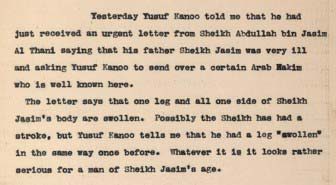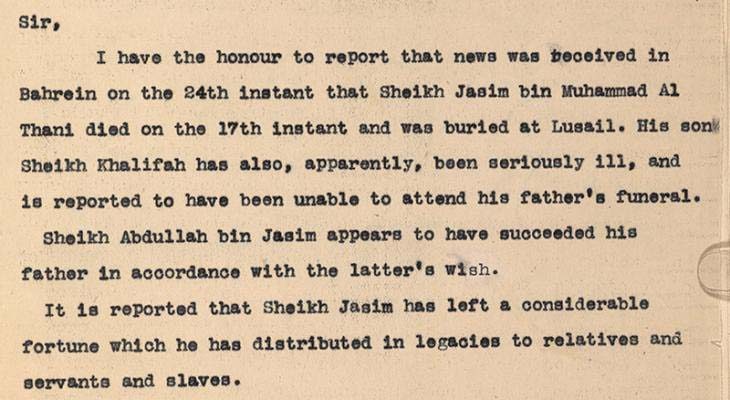
A hand-sketched map from 1823, showing the first-ever recorded rendering of Qatar’s coastline; a British official’s notes from 1782 about rival tribes in Zubarah and Bahrain that make the first mention of Qatar; and a letter from the son of then-Emir Sheikh Jassim bin Muhammad Al Thani confirming his father’s death in 1913.
These are some of the gems from Qatar’s past that have been unearthed following the world’s largest digitalization of historical records on the Gulf Arab states and Iran, which have just gone online for the first time at the Qatar Digital Library.
Included in the archives are maps, manuscripts, sound recordings, photographs and archival material, all free for public and academic use.
The initiative is part of a 10-year collaboration between Qatar Foundation, Qatar National Library and the British Library in London, which began in 2012 and ultimately will see half-a-million documents digitized and made available online.

It will take three years and $14 million to digitize the catalogue of documents, a cost being borne by QF.
The online archives include 475,000 pages from the UK’s India Office records, which previously were only accessible to those intrepid enough to navigate 14km of shelves on the subject at the British Library in London.
The material also includes 25,000 medieval Arabic scientific manuscripts, from the British Library’s own collection.
In contrast to some of the earlier records that start from the mid-18th century, the archives also feature contemporary material, including sound recordings of musicians performing traditional Qatari songs.
Transforming understanding
It is hoped that making these documents more widely available will spark renewed interest in studying the Gulf, both from academics inside the region and internationally.
Dr. James Onley, senior lecturer in Middle Eastern History at the UK’s Exeter University and editor of Journal of Arabian Studies, said in a statement:
“This is a major milestone in the study of these countries. Now anyone can access the region’s fascinating past from anywhere.
“This easy access will enable scholars around the world to discover new things and write new histories that will expand, and ultimately transform our understanding of the region.”
India reported to the British government through the India Office between 1858 and 1947. According to the BBC:
“The India Office did not only administer India, it also exercised colonial rule over an area stretching west as far as Aden. That’s why the files cover Persia and Arabia.”
Some 125,000 documents have already been uploaded to the site, with the rest set to be there by the end of the year. Many chart the relationship between Qatar and Britain over the past 300 years.
Qatar’s records
The first mention of Qatar in the records dates back to Oct. 5, 1782, when the East India Company’s Resident (political emissary) at Bushire, Iran, reported to his colleagues in Bombay of an attack by the Utubi (Bani Utbah) tribe of Zubarah against the Al Madkhur of Bahrain, during the course of which “several lives were lost on both sides.”

Some 40 years later in 1823, the earliest records in the India Office files of a map of Qatar’s coastline appeared with a hand-sketched map of El Biddah – one of the early settlements in what is now Al Bidda district of central Doha.

According to the explanatory note by Dr. Mark Hobbs, a Gulf history specialist at the British Library:
“From the decks of the Discovery and Pysche, the British officers saw El Biddah as groups of houses tightly clustered around two forts, many of which had been damaged the previous year, when the East India Company’s brig Vestal bombarded the town, as punishment for its inhabitants’ alleged involvement in piracy.”
Before that, Qatar was believed to be part of Bahrain, and the peninsula does not feature in earlier maps of the region.
Of social and cultural interest are the documents relating to the death of the then-Emir Sheikh Jassim bin Muhammad Al Thani in 1913, following what is believed to have been a stroke.
The archive features a letter from his son Abdullah to the British political agent in Bahrain, Major Arthur Prescott Trevor, confirming his father’s passing, followed by a number of intelligence reports about the “considerable fortune” Sheikh Jassim had left.
This included pearls, camels and horses in addition to money that he bequeathed in legacies not only to his family, but also to his servants and slaves.

In addition to the original letters, manuscripts, maps and drawings, the site features contextual reports written by British Library experts, to help readers understand the background story to and relevance of many of the items.
The portal also includes contemporary audio-visual material, such as photographs and video clips taken by Rolf Killius, the British Library’s curator of oral and musical cultures, which record sea shanties and other traditional songs, performed in 2013 by local musician Khalid Johar and others.
Speaking at a press conference this week, QF President Saad al Muhannadi said that other international libraries, including German’s Berlin Library, have also been approached to discuss establishing similar partnerships, but that these have yet to be confirmed, Qatar Tribune reports.
Thoughts?







